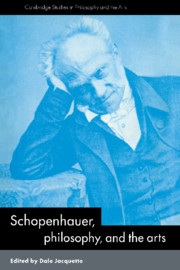Book contents
- Frontmatter
- Contents
- List of contributors
- Editor's acknowledgments
- List of abbreviations
- 1 Schopenhauer's metaphysics of appearance and Will in the philosophy of art
- PART I The work of art: Schopenhauer on the nature of artistic creation
- 2 Knowledge and tranquility: Schopenhauer on the value of art
- 3 Schopenhauer and the aesthetics of creativity
- 4 Art as liberation: a central theme of Schopenhauer's philosophy
- PART II The experience of beauty: Schopenhauer's theory of aesthetic encounter
- PART III Schopenhauer's enduring influence on the arts: idealism and romanticism
- Bibliography of selected sources on Schopenhauer's aesthetics
- Index
4 - Art as liberation: a central theme of Schopenhauer's philosophy
Published online by Cambridge University Press: 05 May 2010
- Frontmatter
- Contents
- List of contributors
- Editor's acknowledgments
- List of abbreviations
- 1 Schopenhauer's metaphysics of appearance and Will in the philosophy of art
- PART I The work of art: Schopenhauer on the nature of artistic creation
- 2 Knowledge and tranquility: Schopenhauer on the value of art
- 3 Schopenhauer and the aesthetics of creativity
- 4 Art as liberation: a central theme of Schopenhauer's philosophy
- PART II The experience of beauty: Schopenhauer's theory of aesthetic encounter
- PART III Schopenhauer's enduring influence on the arts: idealism and romanticism
- Bibliography of selected sources on Schopenhauer's aesthetics
- Index
Summary
SCHOPENHAUER AND BUDDHA
In his youth, Schopenhauer accompanied his father and mother on a long trip throughout much of Europe. The extended journey had a powerful, lasting effect on the young man: London, with its teeming masses and 80,000 prostitutes, appalled him; the plight of 6,000 galley prisoners in Toulon horrified him; and the general misery of human life in all of Europe stamped itself on his mind, never to be eradicated. In later years he was to recall:
In my 17th year, without any learned school education, I was gripped by the misery of life, as was Buddha in his youth when he looked upon sickness, old age, pain, and death … and my conclusion was that this world could not be the work of an all-good being, but rather that of a devil who had brought creatures into existence in order to take delight in their suffering; to this the data pointed, and the belief that it is so won the upperhand.
By the time Schopenhauer came to compose his “main work” The World as Will and Representation (1814–1818; publication date 1819), he no longer regarded the world as the (causal) work of a devil, but as the (noncausal) manifestation of something just as evil – the nonconscious, insatiable will. Consequently, Schopenhauer inferred, the only “way out” of this world of misery and suffering is the denial of the will (or, as he proceeded to put it, the denial of the will to life).
- Type
- Chapter
- Information
- Schopenhauer, Philosophy and the Arts , pp. 81 - 106Publisher: Cambridge University PressPrint publication year: 1996
- 3
- Cited by



